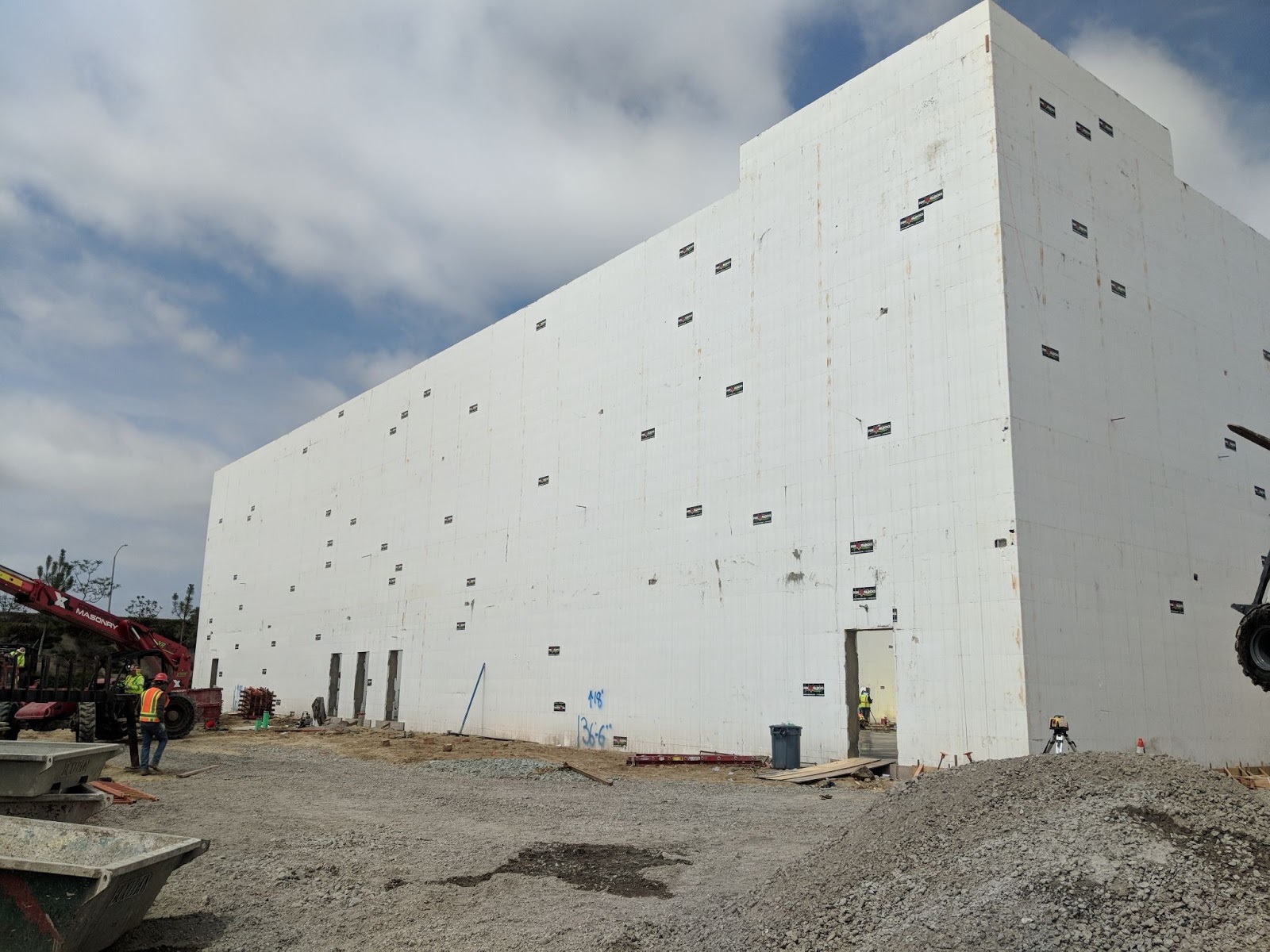
What is a Shear Wall and How Does it Protect Your Building?

Shear wall definition: Shear walls (shear panels) protect a home or building from becoming warped or distorted when attacked by horizontal (lateral) forces during an intense wind event, hurricane, or seismic event.
For many years, builders constructed shear walls with wood or steel framing. However, today builders have a better alternative shear wall material ﹘ Insulated Concrete Forms (ICFs). ICFs provide more protection against lateral loads from earthquakes and severe winds than wood or steel framing. ICFs also provide quicker and easier construction and more energy efficiency, durability, and indoor environmental quality than framed-shear walls.
What is a Shear Wall?
A shear wall supports the weight (compression) above it, transferring the load along wide, vertical-oriented beams to the base of the wall. The shear wall includes a wall bracing system that simultaneously resists uplift, compression, and sliding forces caused by lateral loads so that the wall will not twist and collapse, causing a roof to rotate and fall — racking:
Uplift: Lateral forces create uplift on one end of the wall system, forcing the wall to roll off the foundation.
Compression: While one end of a wall experiences uplift, the opposite end will experience compression. The two loads alternate as the structure shakes back and forth.
Sliding Resistance: Lateral forces that attempt to slide the wall off its foundation.
When Are Shear Walls Required?
Most homes and buildings in high-wind and earthquake-prone regions require exterior shear walls. However, larger houses and high-rise structures also need interior shear walls to protect against lateral wind and seismic forces.

What is a Shear Core?
Tall multi-story buildings require shear core walls to resist damaging lateral forces from strong winds and earthquakes. Shear core construction occurs in the building’s center, typically encased in box-shaped sections around an elevator or a stairway.
Shear Wall Vs. Load-Bearing Wall
When choosing between a bearing wall vs. a shear wall, you must consider how prone the region is to lateral loads and the height of the building.
Shear wall structural systems resist lateral loads (horizontal forces acting on a structure) of wind and seismic activity, carrying the compression loads (vertical forces) from the weight of the building components (beams, girders, etc.) down to the foundation.
Load-bearing walls only carry the compression loads down to the foundation but lack bracing, so they do not resist lateral loads.
How Do Shear Walls Work?
Ideally, the shear wall details and design includes walls on all sides of the building, extending its entire height. Long walls are more robust than short walls, and solid walls are better than walls with openings (windows, doors, etc.).
In addition, the design of a shear wall should ensure that the building can survive severe sideways (in-plane) forces (racking and shear) without being damaged or bent out of position. In addition, to provide earthquake resistance in low-rise structures, builders must sufficiently anchor the shear wall by installing steel reinforcing bars that extend across the joint between the walls and the foundation.
What is Shear Wall Technology?
Shear wall technology refers to the building science behind resisting lateral loads. Shear walls contain a movement-resisting frame, consisting of two or more walls connected by slabs or beams with the beams rigidly connected to the columns. The rigid shear wall framing provides resistance to lateral forces, developing bending movement and shear force in the frame joints and members. The lateral stiffness of shear walls lessens interstory distortion caused by earthquakes and severe winds.
Placement of Shear Walls
The shape and placement of the shear wall will considerably influence the structure's behavior. Structurally, shear walls work best in the center of each half of the building, placed symmetrically around the structure’s central axis. However, architects find this challenging since shear walls take up so much space. Often, you will find shear walls around stairwells, elevator shafts, or windowless walls.
How to Build a Shear Wall
Construction of a shear wall includes materials and design that enhance a structure’s stiffness, strength, and ductility in order to withstand lateral forces from severe winds and earthquakes. In most U.S towns and cities, Chapter 16 of the International Building Code and Chapter 6 of the International Residential Code provide a construction guide for designing and constructing shear walls.
How to Identify a Shear Wall
Shear wall construction drawings identify a shear wall by a solid line with a thinner line indicating a covering of sheathing.
Shear Wall Material
You can use any structural material to build a shear wall; however, the strength of the material must equal or exceed the surrounding structural material. Three common shear wall materials include steel plates, wood, and ICFs.
Steel plate shear walls consist of vertical steel infill plates one story high and one bay wide connected to the surrounding columns and beams. When installed in one or more bays for the full height of a building, the plates form a stiff cantilever wall. Often used to strengthen existing 4 to 8 story buildings.
Shear Wall Construction with Steel Plates
The steel plate shear wall composition includes a thin steel web plate bounded by and attached to a rigid beam supported at either end by stiff columns (portal frame). The rigid joints between the beam and columns permit the transfer of the bending force in the beam to the columns.
Wood shear walls contain relatively low strength and stiffness compared to steel or reinforced concrete, making them suitable for lightweight construction. A seismic-resistant wood wall requires several long or many shorter shear walls.
Shear Wall Construction with Wood
Wood shear walls consist of attaching sheathing (plywood or OSB) to wood frames. Constructing wood shearwalls can become labor intensive and has additional costs for some mechanical connectors and fasteners. Builders fasten the sheathing to the framing with nails sized and spaced according to an engineer's specifications. Finally, they mechanically attach the sheathing to the foundation walls with metal connectors and/or metal cross-strapping.
Reinforced, cast-in-place, concrete shear walls (like those built with ICFs) are a highly reliable shear wall material for medium to heavy construction. ICF shear walls achieve all the vital properties of earthquake resistance. The strength of concrete resists compression forces, and the reinforced steel manages the lateral forces. The reinforced concrete shear walls' high level of ductility allows architects to design with shorter wall lengths compared to other materials.

How to Build an ICF Shear Wall
Building an ICF wall involves pouring reinforced concrete into hollow extruded polystyrene foam panels, separated by six to eight inches of reinforced rebar. Workers dry-stack the interlocking units, then carefully pour the concrete. The cured concrete of the inner and outer polystyrene ICF panels creates a permanent exterior framework.
Why Fox Blocks ICFs Are the Superior Option For Shear Wall Construction

Fox Blocks ICF walls, which extend the entire height and all sides of the structure, provide significantly higher structural capacity and stiffness to withstand the in-plane shear forces during a strong wind event or earthquake than wood or steel frame walls. In fact, a study reported by the Portland Cement Association (PCA) compared the resistance to structural stresses of ICF walls to conventionally framed walls during earthquakes. The ICF walls resisted a maximum lateral load 6 to 8 times the maximum loads resisted by the frame wall panels. Fox Blocks ICFs provide tremendous potential for lessening property loss from heavy winds and earthquakes.
High-performing Fox Blocks ICF also creates energy-efficient buildings and homes with good indoor environmental quality, excellent durability, and superior fire resistance. The Fox Blocks wall system, in addition to providing excellent shear walls, are a quick and easy all-in-one wall assembly, combining five steps into one, including structure, insulation, air barrier, vapor retarder, and attachment, saving both time and money.
Fox Blocks professionals are here to help you with tips on shear wall installation.